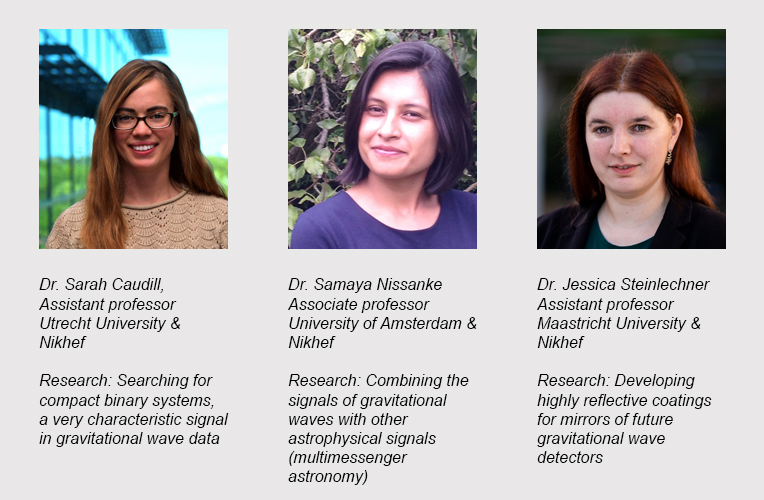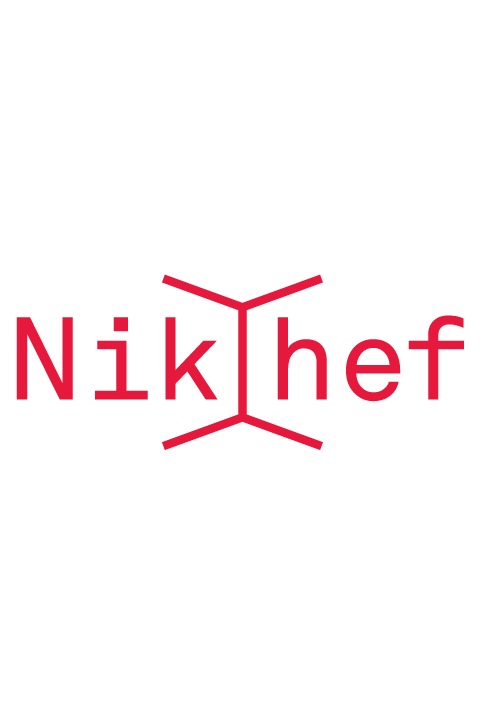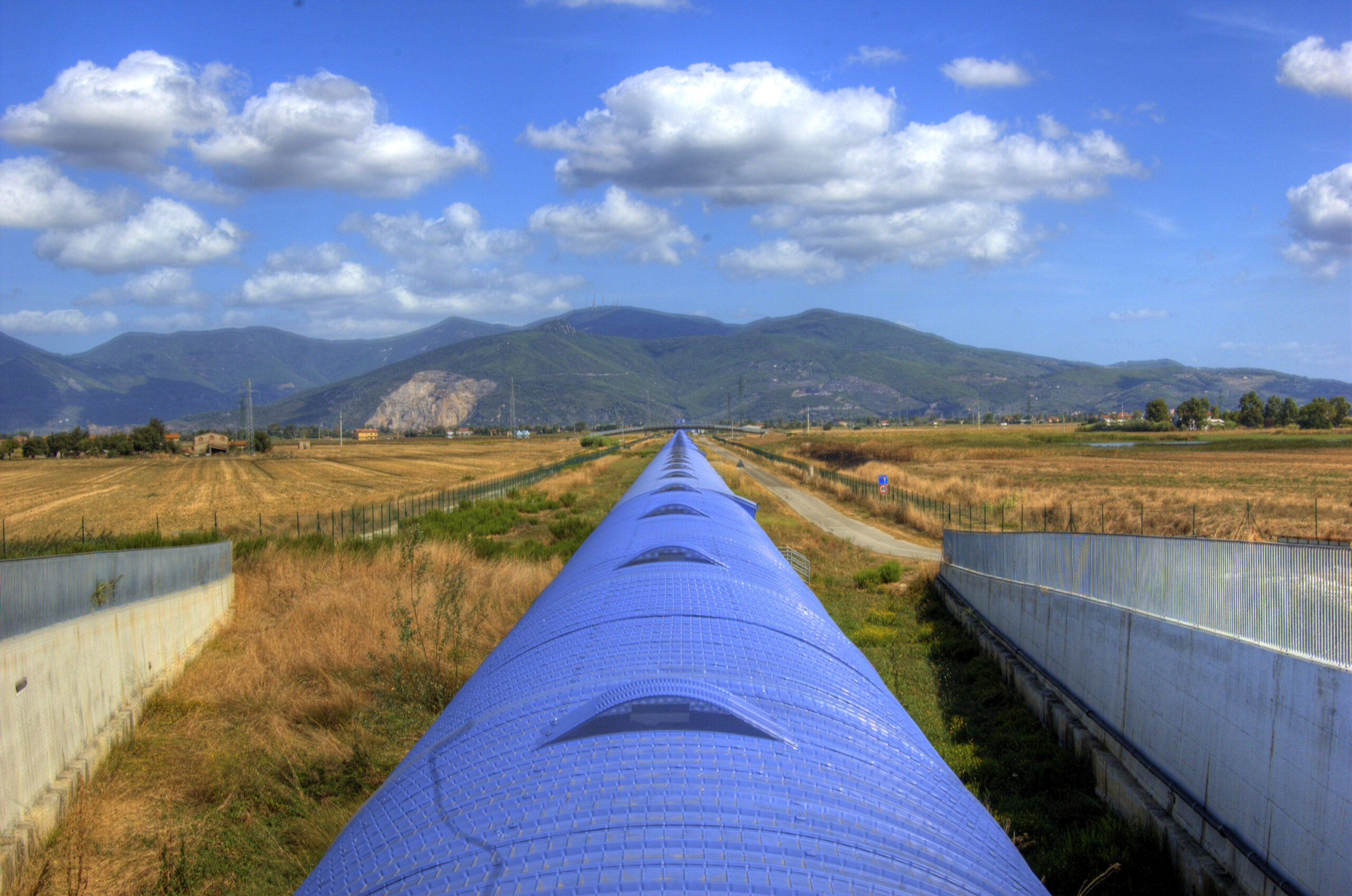It’s exactly five years ago that scientists announced that they had managed to detect gravitational waves. The actual first detection was in September 2015, and confirmed a prediction of Albert Einstein of a hundred years ago. The discovery was world news, because scientists now had a new way of studying the universe. Until then, they only could use light, radiation or radio waves. But now they could also ‘feel’ what’s happening. This enables them to peek into the dark parts of the universe for the first time.
The announcement happened to coincide with the first ‘International Day of Women and Girls in Science’, that had just been established by the United Nations. Although there is room for improvement, many great female scientists work in the field of gravitational wave research and were involved in this discovery as well as future infrastructures. Today, three of them reflect on the event that took place five years ago, and share their expectations for the future of the field.
The detection of gravitational waves was announced during a big press conference in Washington on 11 February 2016, with livestreams all over the world. Where were you at that time?
Nissanke: ‘I was in Pisa, in Italy at the site of the Virgo-detector. I was there for the press conference, and I remember it was really surreal. It was amazing to be in the room, with so much attention from the press. I also remember being exhausted. Not just because I was six and a half months pregnant, but also because we had been writing papers for months, with many endless nights. Then at this moment there was the opportunity to sit back and think ‘Wow, look what we human beings have been able to discover.’
Steinlechner: ‘I was in Glasgow at the time, and we were invited with 60-70 people to have an online session in the main building. There we all watched the press conference together. It was quite exciting, a celebration-type of event. It was nice to see that people appreciated it that a group of people in this university was working on this. We mainly felt the impact of the event in the month that followed, when we noticed how much attention we got from the media. And more people contacted us and wanted to collaborate.’
Caudill: ‘Actually, I was in the standby room at the press conference in Washington DC. My advisor Gaby González was one of the people leading the announcement. Not just the people around me were happy and excited. I remember my social media flooded. And my high school friends and family were reaching out. It was really exciting, for about a week people were talking about nothing but science. I had been working in the collaboration for 10 years. For me it was really refreshing to see that all that work was paying off.’
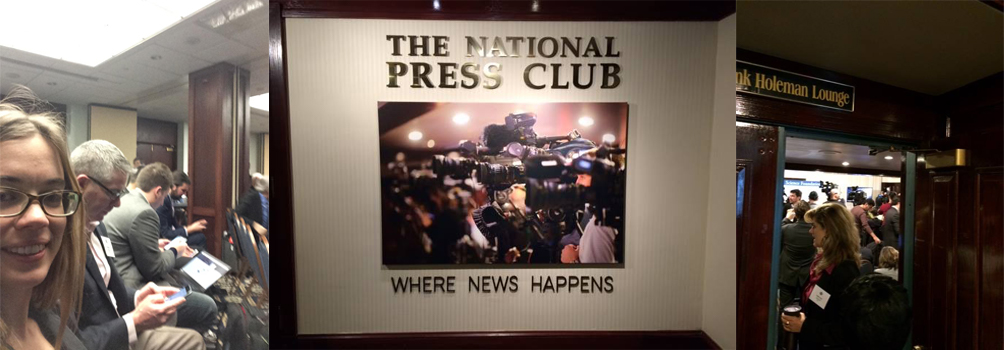
Of course the actual detection was done on 14 September 2015. When did you first know about this detection?
Caudill: ‘We knew about the detection on the day it arrived. But the signal was so loud and so clear that we thought it must be fake and was meant to be a test. Some people were actually mad about that, because we were still starting up and they wanted to focus on other things. But then it became clear that there was no way that this was a test. And as time went on, the detection got confirmed more and more. We were also surprised that it was a binary black hole system. We didn’t know for sure that they existed before, there was no evidence because they do not emit any light.’
Nissanke: ‘I knew it on the same day as well. I was at the University of Oxford, giving a workshop on how to follow up a gravitational wave sign to quite a sceptical audience. I had been giving workshops like this for 6 or 7 years, and telling the story that we would probably see a gravitational wave in 2021 or so, after an upgrade of the detectors. So when I got the message I was intrigued and curious. I didn’t believe this was a real event at first. A handful of people in the room got an email alert, so there was a lot of curiosity and excitement in the room that week. Then it took months to sink in, and to confirm that it was real. And all the work I had done for 15 or 16 years suddenly made sense.’
Steinlechner: ‘For me there was no ‘big moment’ as the information started to come in slowly from different channels. The first time I realised it actually had happened, was when I got an email saying ‘something happened, please don’t tell anyone’. It was an exciting time, but also weird. We were in this in between state. And once the detection was confirmed, it was still weird because we were not allowed to tell anyone. It seemed to be a very long five months between the first detection and the press conference…’
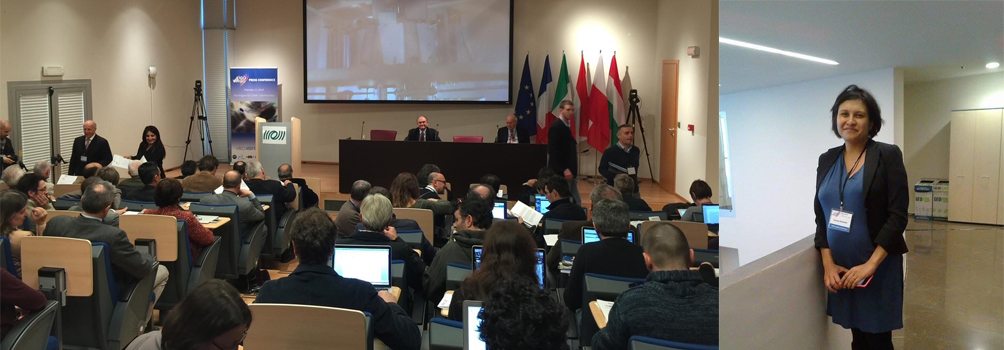
Now it’s five years later. Has the field of gravitational wave research changed since the first detection?
Nissanke: ‘Today there are at least 50 compact object mergers that have been observed, checked and analysed. And there are even more events in the data that we haven’t analysed yet. That’s kind of crazy if you think that it started with that one event. You feel you are in a field that’s rapidly changing. Now we’re in a completely observation driven field. The field is also growing, there are now thousands of people working on it. And many subfields have opened up, like big data, artificial intelligence and machine learning. It’s kind of beautiful, seeing a field explode like that. Students are also excited and a younger generation is now coming into the field.’
Steinlechner: ‘Clearly gravitational wave research got a lot more attention, funding and the community working on gravitational waves grew a lot. There are more people and more groups working on it.’
Caudill: ‘And we are much more comfortable with our detections now. There are also more external groups analysing data and doing detections. Detecting binary black holes is a routine now, it happens once a week. Binary neutron star systems are still exciting. We are making sure the analysis is fast, so we can do multimessenger astronomy and tell astronomers where to look. People are also getting more interested in exploring more extreme systems. They also want to look at dark matter, and probe exotic matter systems like quark matter. In short: we are much more comfortable with our detections and are using that to think about what else is possible.’
Many observations have been made, and the field has developed rapidly. What do you think is the most interesting result so far?
Nissanke: ‘In August 2017, we detected two merging neutron stars, and every part of the electromagnetic spectrum was being observed. That was mind blowing. I had been thinking about this for ten years almost every day. I was focused on the theory and simulations of an event like this. And I always thought this is something that could happen one day. And when it did happen it was mind-blowing. Even emotional.’
Caudill: ‘For me the detection of those merging neutron stars in 2017 was also kind of the coolest. It’s unique and we haven’t detected a lot of those, only two. Another detection I like is the heaviest black hole system we found in May 2019. It was the first black hole merger that resulted in a black hole of intermediate mass (142 solar masses). Previously there was very little evidence that these events could occur, and it’s a mystery how it formed. But the fact that it exists fills a missing link to supermassive black hole formation.’
Steinlechner: ‘I work more on the instrumentation, so I am not the best person to tell which scientific discovery was the greatest. But one other result for me is the start of the Maastricht science group. That might not have happened without the detection of gravitational waves.’
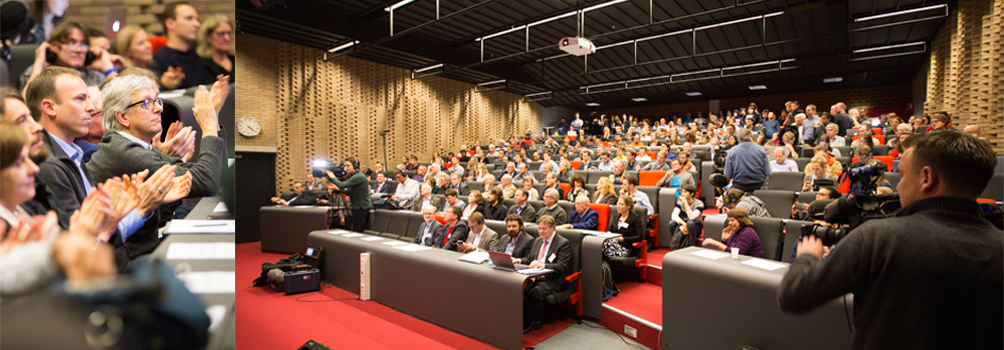
And we are only at the start… what can we expect from gravitational wave research in the future?
Steinlechner: ‘We are dealing with very long time scales. So it’s hard to make a precise prediction of what will be discovered exactly. But we can expect many more and other exciting discoveries and new things. Even with the minor upgrades of the LIGO detector after the first detection, we could already see a lot more. And of course we are taking the next steps, because we are preparing for the future detectors: the Einstein Telescope and the Cosmic Explorer. If they are ready in 15 years or so, that will lead to even more exciting new discoveries.’
Caudill: ‘We will continue doing more of what we are doing now, and get more statistics of black holes of different masses. I hope we can also detect black holes that are smaller than one solar mass. They have formed in a completely different way. Not by the death of stars, but in density collapses in the early universe. That is a completely different system, and a candidate for dark matter. With the future Einstein Telescope we can expect much more detections: thousands every couple of days, instead of one. And also signals of different lengths, really short ones as well as day-long signals. The variety of signals and the increased numbers come with several computational challenges, and we have to adapt algorithms and the computer infrastructure.’
Nissanke: ‘What is most exciting to me is that we may discover things we don’t expect. That has yet to come. And then it will be a puzzle to find out what it is. But the increased number of detections is also exciting. We’ll get a whole catalogue, it’s going to be huge for astronomy and cosmology. I also expect we will detect more neutron star mergers with electromagnetic radiation, especially with the KAGRA-detector that is being built in Japan. And with LISA we can potentially see every supermassive black hole. It’s really a time machine, using mergers as probes to understand how the universe formed.
And… I am hopeful the demographics of our research community will change. It would be good to have more women and underrepresented minorities in high energy physics. In the Netherlands and the US there is a lot more that can be done to get 1st and 2nd generation scientists involved. Representation is key. So yes, equity and inclusion. We have to be critical and work on this.’
The border area of the Netherlands, Belgium and Germany is a candidate site for the Einstein Telescope. What would it be like to have this next generation gravitational wave observatory so nearby?
Steinlechner: ‘That would be extremely exciting. After having been working on it for such a long time, it would be the best thing ever if it would be built so close to my front door. Of course the most important thing is that it will be built at all, whether it is in the border area of Limburg or in Sardinia. That is more important than the exact place. But the thought to be close when it is being built, that’s super exciting.’
Nissanke: ‘I really hope it comes to the Netherlands. It will bring so much to the Netherlands, Belgium and Germany, also for the local population. It will be a bit like a small CERN and will transform the region. And it will be a privilege to be involved. The science, technology and infrastructure will be so huge. It’s very inspiring and will exemplify the global field. The Netherlands is a good candidate to take on that kind of big project. And it will train a huge generation of scientists. That will be immense in terms of societal pay-off.’
Caudill: ‘I lived in Louisiana for a while, near the LIGO Livingston site. There I experienced that it’s really valuable to have the detector and the search scientists in one place. If the Einstein Telescope would be built here, the Netherlands would be the leader in gravitational wave astronomy in the world, together with Belgium and Germany. A lot of people already moved here, or are investing to come. And it provides lots of opportunities for young people. You don’t even have to become a gravitational wave researcher, you can also learn about detectors or machine learning or something else. The future is looking very bright, and I am excited about this.’
Interview: Martine Oudenhoven
